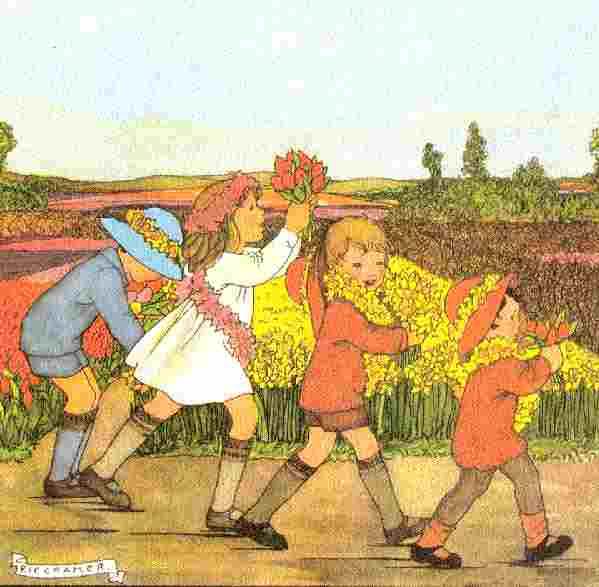
Dutch Boys' Clothes: Chronology--Inter-War and War Years (1920-45)

Figure 1.--This idealized drawing shows a view of Dutch children's during the 1930s. The blooming flowes date the image to the spring. The boys wear sweaters with short pants and kneesocks. I'm not sure what the younger boy is wearing. The girl wears a white smock or frock.
|
Dutch boys in the inter-war years increasingly wore short trousers with kneesocks. Younger boys might wear long stockings during the winter. Older boys might wear knickers. Some boys still wore sailor suits. Some of the traditional styles like baggy trousers, smocks, and wooden shoes declined during this period. Few fashions developments occurred during the difficut years of German occupation (1940-45).
Major fashion changes for boys and adults ocurred in the 1920s, following as it did the cataclism of World War I (1914-18). The Netherlands maintained its neutrality during the War, but was not unaffected by the hostilities ranging around it. Boys still commonly wore sailor suits, especially in the early part of the decade. Flat caps were popular as well as a style of peaked student caps. Sweaters were very popular. Many boys wore sandals.
Boys fashions in the 1930s take on an increasingly modern look, especially shirts and sweaters. Boys wear both collared and colarless shirts--although the modern "T"-shirt is not yet seen. Kneepants are no longer seen. Short pants are widely worn by boys year round. The cut is increasingly short, especially for ypounger boys. Older boys might wear knickers, especially during the winter. Both kneesocks and ankle soicks are worn. White kneesocks had a rather dressy look. Some boys wore sandals. Younger boys might wear strap shoes with dressy outfits. Folk dress was still seen in some isolated areas, but to a much lesser extent than in the pre-World War I era.
HBC believes that fashion essentially stood still during the World War II occupation of the Netherlands by the Germans. Boys appear to have continue wearing rather much the styles of the late 1930s. I do not know if the Germans introdfuced any new styles in the early 1940s. Presunably German styles were already common. Dutch boys may have been willing tomwear German styles when in 1940-41 it looked like the German wre the wave of the future. Later in the War boys may have been motivated to reject German styles, although clothing must have been very sacrce in 1944-45. Boys commonly wore short pants suits, although some younger teenagers had knicker suits. Long pants syits were not very common--except for younger boys. Some boys wore sandals--but they were not very common buy the teen years.
Christopher Wagner

Navigate the Boys' Historical Clothing Web Site:
[Introduction]
[Activities]
[Bibliographies]
[Biographies]
[Chronology]
[Clothing styles]
[Countries]
[Contributions]
[FAQs]
[Dutch glossary]
[Satellite sites]
[Boys' Clothing Home]
Navigate the Boys' Historical Clothing Dutch pages:
[Maiken Island]
[Dutch choirs]
[Dutch scouts]
[Dutch school uniform]
[Dutch boys bangs]
[Dutch catalogs]
[Dutch post cards]
Navigate the Boys' Historical Clothing national pages:
[Return to the Main Dutch chronological page]
[Return to the Main Dutch page]
[Australia]
[Belgium]
[England]
[France]
[Germany]
[Ireland]
[Italy]
[Japan]
[Korea]
[Mexico]
[Scotland]
[United States]
Created: March 2, 2001
Last updated: November 16, 2001



